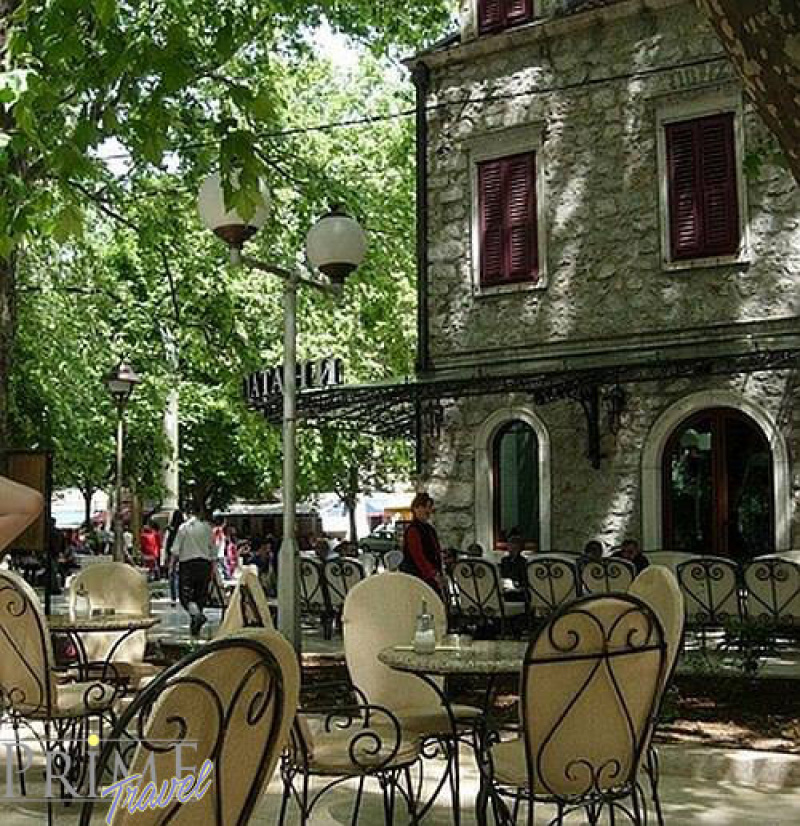
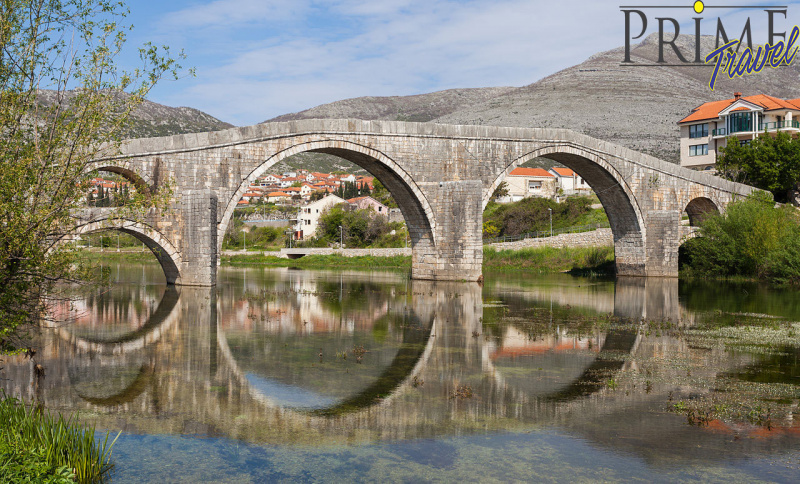
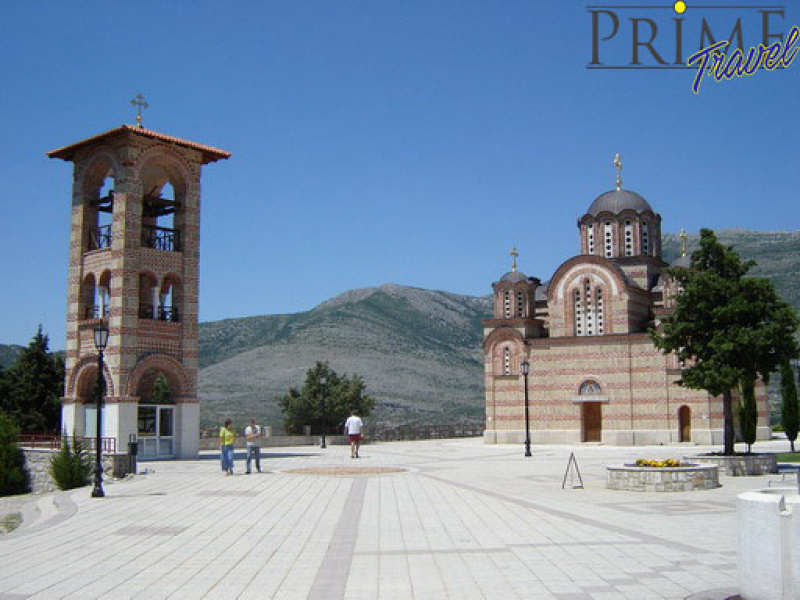
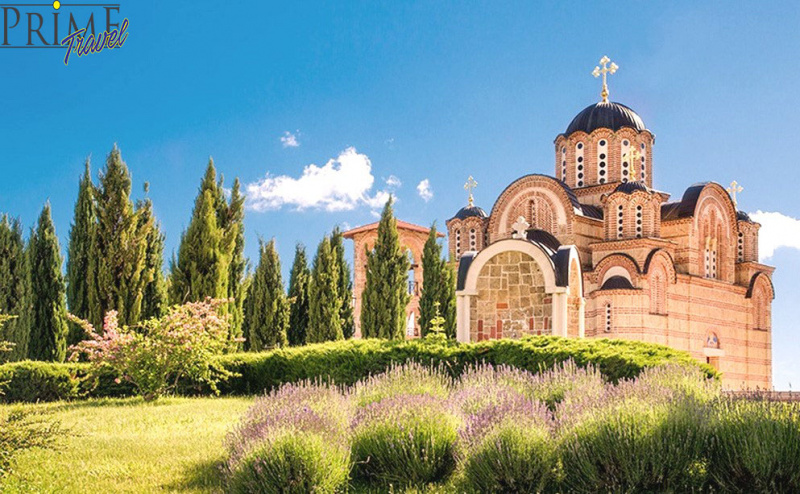
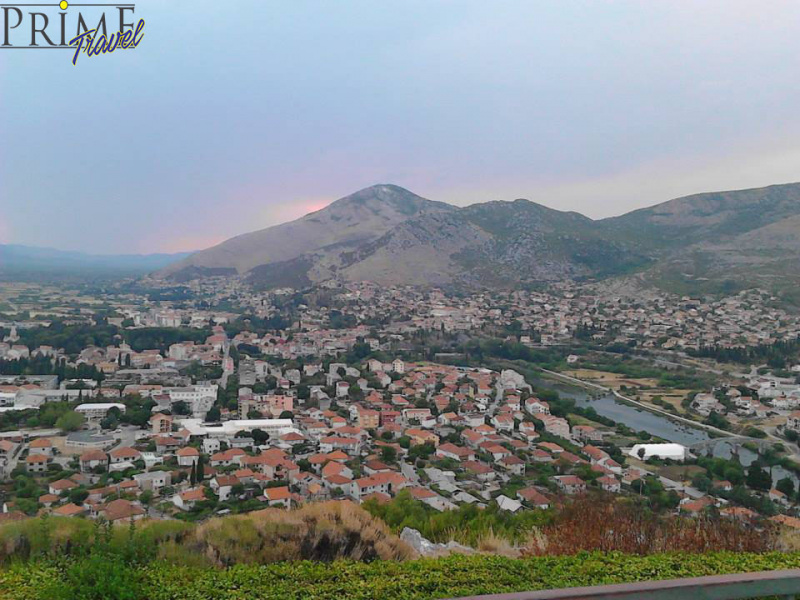
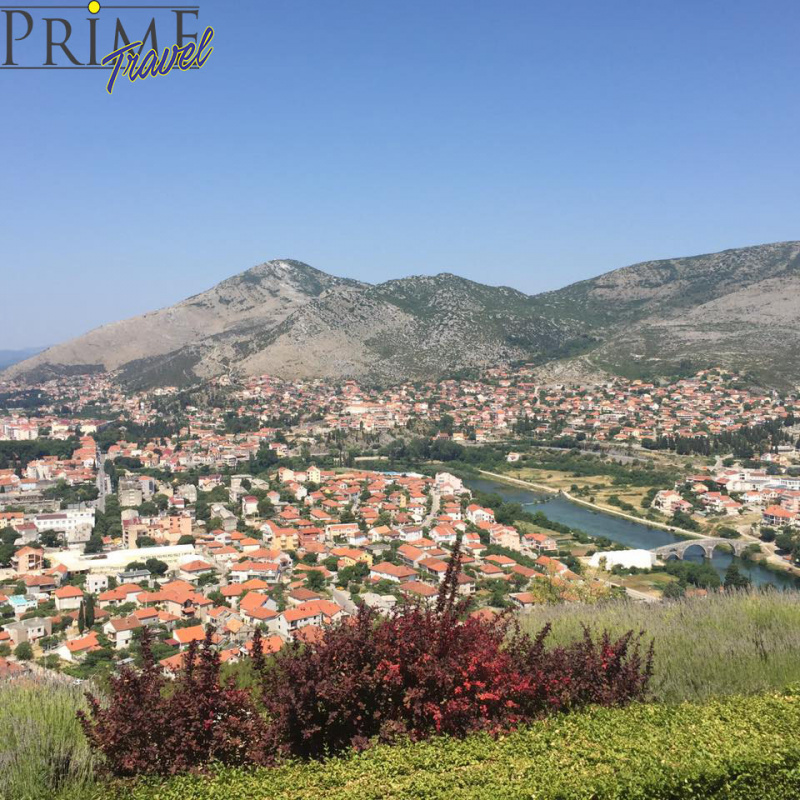
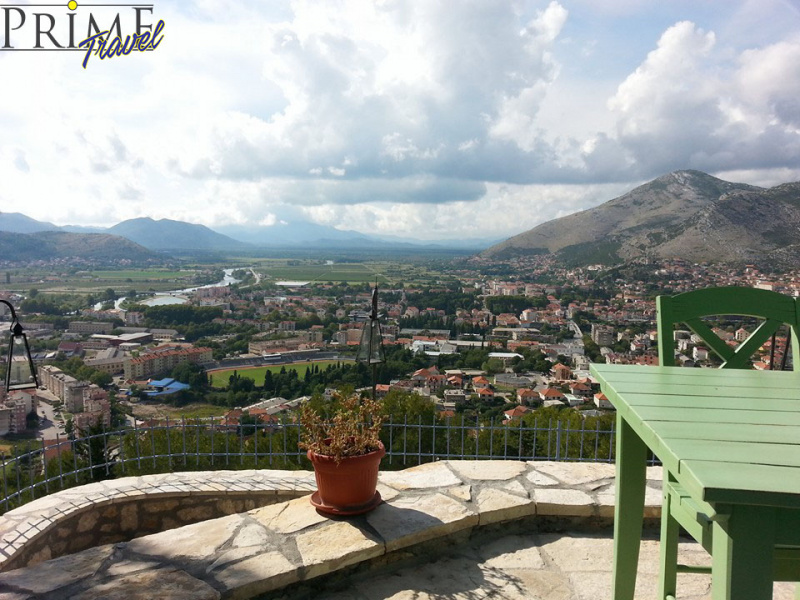
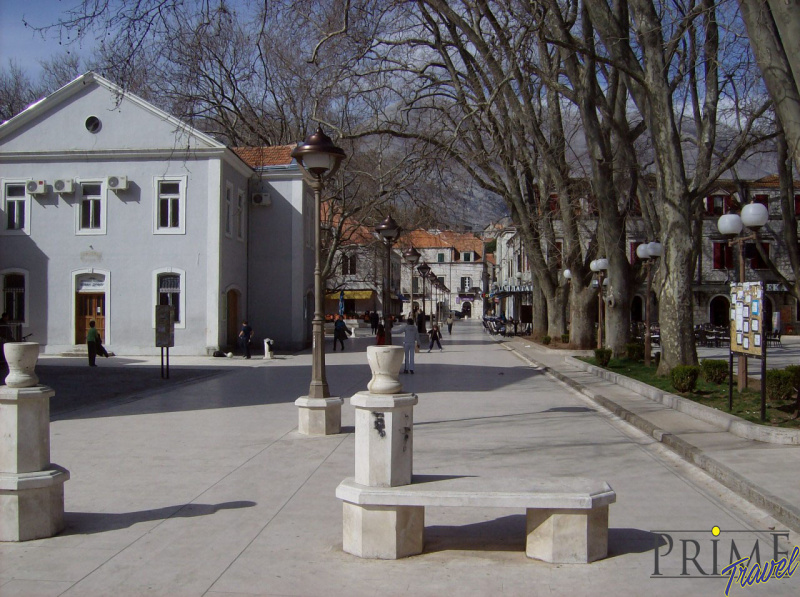
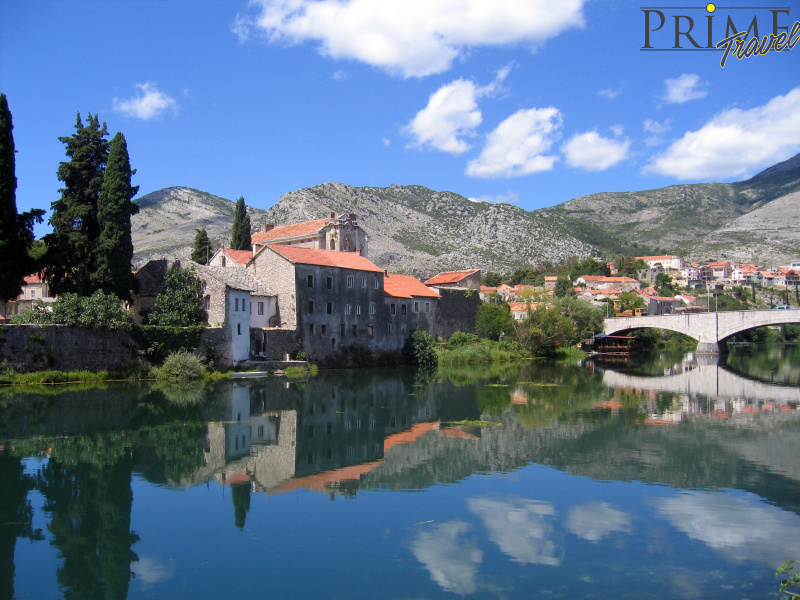
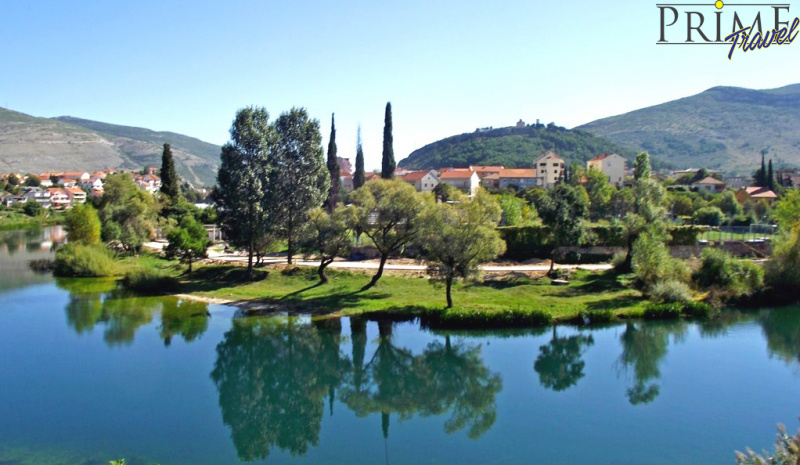
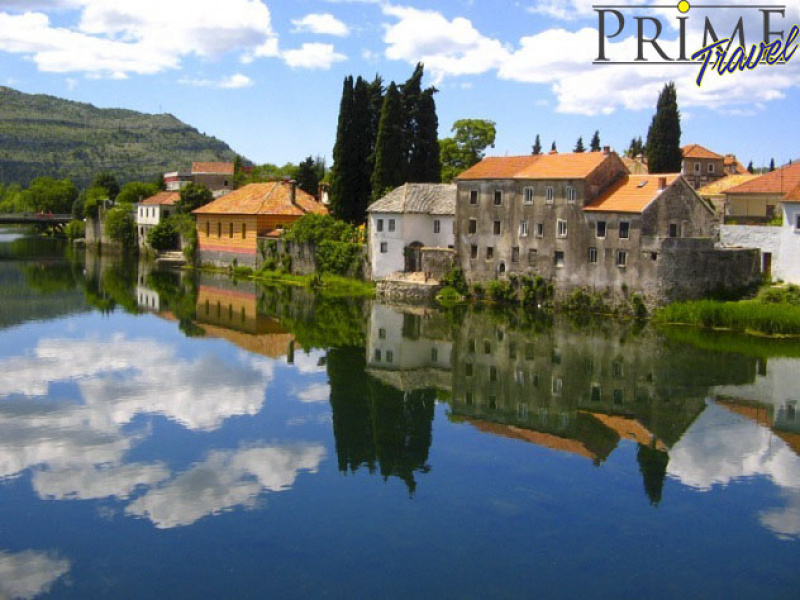
Price: Contact us
Trebinje, one of the most fascinating Herzegovina towns, is a small urban centre in the southern corner of the country, at about 113 km from Mostar. It developed under Byzantine influence, under the Ottoman Empire and during the Austrian-Hungarian epoch. Its historical centre lies on the banks of the Trebišnici River and was mentioned for the first time in the 10th century by the Byzantine historian Konstantin Porfirgenit. Some of the most important monuments are: the Monastery of Tvrdoši (15th century); the Arslanagić Bridge, built by the Ottomans in 1574 as a vital passage way for the commerce of salt; the Osman Paša Mosque (1726) and the New Orthodox Monastery, known as “Gračanica of Herzegovina” (it was built on the model of the Monastery of Gračanica in Kosovo), standing on the hill, south of the city. Inside the Monastery lies the poet and diplomat Jovan Dučić. The tree-lined square Jovan Dučić is a meeting place for the people of Trebinje and, in the morning, it holds a very popular and lively market.
Sights you can visit in Trebinje:
Herzegovacka Gracanica
special magnificent building from 2000 - is dedicated to Mother of God. Obeying wish of poet Jovan Ducic, expressed in his will, the temple of the Mother of God was raised on hill Crkvina, in which Ducic was buried. This temple is a true copy of the monastery of Gracanica on Kosovo i Metohija and because of that it is also called Hercegovacka Gracanica. This religious complex includes bell, icon gallery, parish’s home, amphitheater, fountain, church bookshop, museum and summer garden restaurant. The temple can be seen from any point in Trebinje and it is the most beautiful sacral building in the whole Herzegovina. It was the poet’s wish to be buried in Trebinje, so, his mortal remains were moved from America to Hercegovacka Gracanica in October of 2000.
Tvrdos (the 4th-6th century)
Monastery Tvrdos, which is 4.5 km faraway from Trebinje, on the road to Mostar, has been built on the foundations of an old church. At the beginning of the 16th century the monastery was painted by Dubrovnik’s icon-painter Vicko Lovrov and Trebinje’s monk Marko Stefanov. In the first half of the 16th century monastery of Tvrdos was the biggest writing-room in Slovene south, and, at the same time, it was cultural and spiritual centre of the wider area.
Zavala (the 13th century)
Monastery Zavala is 40 kilometers remote from Trebinje in southwest. Folk oral tradition has it that the monastery is pious endowment of king Dragutin. When the time of its foundation is discussed, the year 1271 is often mentioned, which is inscribed in an old monastery’s stamp.
St Paul and Peter’s (the 6th century)
St Paul and Peter’s monastery is located in Peter’s field, 5 kilometers southeast from Trebinje. New church was built at the beginning of 20th century on the foundations of old one, which allegedly dates back to Justinian’s age. Archeological finds have testified to very old buildings that there were at the place of current monastery, probably from the age of early Christianity. Monastery’s complex is consisted of the apostle Peter’s temple, raised in 1906 on the remains of older temple, the remains of the apostle.
Duzi (the 16th century)
Monastery Duzi has been consecrated to the cover of Mother of God. It is situated on the left shore of the Trebisnjica River, 10km downstream of Trebinje. In the 16th and 17th century it was the property of the monastery Tvrdos. They restored and enlarged the church and property, which still has been well-known by the same name. Until the end of existing of Pecka Patrijarsija in 1776, this monastery was the centre of metropolitan bishop of Herzegovina. It was robbed and devastated several times. The monastery possesses valuable hand-written church books, even Russian editions from Moskva and Kijev. There is also a fragment of honorable cross in it.
Monastery Dobrićevo (XIII vijek)
One of the most outstanding monuments of our cultural-historic past is for sure monastery Dobricevo. It is considered to date from the 18th century. There is the legend which says that the monastery was built by Tsar Konstantin and empress Jelena after they returned from Rome. While they were staying at this place and having a rest they commented: “It was good”, and according to that the monastery got the name Dobricevo. The church is built in Byzantine style, in the shape of cross, and is consecrated to Mother of God. In its history the monastery was burnt three times, the first time in 1694, the second time in the period of the First World War and the third time in the period of the Second World War.
The Arslanagica Bridge
The Arslanagica Bridge was built by Mehmed-pasha Sokolovic in 1574, during Turkish occupation. It has been his pious endowment to his son who was killed in fights with Venetians. When Turks were pushed out of Herceg Novi in 1687, many Turkish families from this town moved to Trebinje. Among them there was Arslan-aga. He got possessions in the east from Trebinje: on Zubci, Necvjece and Jasen, as well as the right to charge bridge-toll across the bridge on the Trebisnjica River. Since then, the bridge was named the Arslanagica Bridge after him. Since 1993, the bridge has also been called the Perovica Bridge.
The Catholic Cathedral of nativity of the Virgin Mary (the end of the 19th century)
Thousand years of existence of trebinjsko-mrkanske bishopric was celebrated in 1984. The bishopric was first mentioned in the bull of Benedict the 8th (1012 – 1024) that is published on the 27th of September in the year 1022. During its long existence, the bishopric was passing through different difficulties that were caused by political and social factors. On the 31st of May in the year 1984, the small church in honor of Virgin Mary was proclaimed cathedral.
Minster of St. Transfiguration (the end of the 19th century)
The Orthodox Church of St Transfiguration has been built since 1888 until 1908. It is located in the centre of the town. Well-known Montenegrin artist Marko Gregovic, who was helped by Atanasije Popovic, made iconostasis in this church. Next to the Church of St Transfiguration, an eparchy with library has been built. Choir of St Vasilije Ostroski also function as part of this temple.
The Osman-pasa’s Mosque
This is the mosque located in the Old Town, not far away from the main gate and town's walls. It is built of ashlars and covered with quadrilateral roof, as imitation of cupola under etemit. Along the right wall is raised stone octagon minaret, 16 meters high, and it was one of the most beautiful minarets in Herzegovina. It was built in 1726 by orders of Osman-pasha Resulbegovic. Builders were masters from Dubrovnik. There are elements of Mediterranean architecture in its structure. It is believed to be the most spacious mosque in Herzegovina. It was demolished during the last war. Foundation stone for restoration was laid in 2001, on May 05. The mosque was inaugurated in 2005, on July 15. According to dimensions and materials which were used in its building, present Osman-pasha's mosque is authentic to the one which was demolished.
Fortification “Strac”
Trebinje is surrounded by former Austrian military fortifications. One of them is fortification “Strač” above Trebinje. It is situated in the southeast from Trebinje and it is possible to arrive there by car by an old Austrian road that leads from hill Crkvina to village Rapti, and then, on right side from Rapti, at the distance of about 2km, at the top of the hill is hidden miracle of architecture for that and for all times. It is said that “Strač” had 365 rooms in walls that are 1 meter and more thick. All the rooms were mutually linked and they had the system of inflow of fresh air and rain-water is used for water supplying. At the top of the fortification are iron cupolas whose walls are over 30 centimeters thick. From the fortification there is a view of Zubci, Petrovo field, Trebinjse forest and Trebinje.
Branković’s tower
It is assumed that old and the first Trebinje was situated from the church at the river and to the top of Crkvina which dominates by that area. Brankovic's tower is also placed in that area. The Brankovic were an old and respectable family. They lived and worked in the period of the biggest rise of Serb's state, in the period of king Milutin and Stefan Decanski, as well as king and emperor Dusan. They were on historic stage from the first part of the 14th until the first part of the 16th century. The museum in St. Petersburg keeps a belt with embroidered name. Branko and the Lion as a symbol of home Brankovic. Vuk is the youngest son of Branko. He was born in 1345. In the time of collapse of Serbian empire he withdraws to Kosovo. Brankovic's tower in Police represents one of older and not so well-known monuments of our past
Roman bridge Vučija
Roman bridge in Vucija is a great secrecy like all old bridges whose construction is attributed to Turkey. Roman bridge on Vucija is the most interesting and it is seems to be the oldest one. It was probably built at the same time as Lastva's towers. Old bridge on Susica on Vucija is placed between two big rocks and it connects two steep parts under the river. The bridge used to be called Old Bridge, Greek Bridge, and bridge on Susica, and the residents outside Vucija call it Vucijanski Bridge. It is built from cut stone and upper arches from dripstone. Upper part from dripstone is joined by semicircular arches so that it is very nice impression and it fits into natural surroundings. There is a legend which says that at the time of queen Kuljaca there was the same bridge like this one on Zaslapnica, farther down for about 200 meters, and that it was taken away by rising waters.
Garden "Platani"
Big summer garden "Platani" has 500 seats and natural shade under hundred-year-old line of plane-trees. The garden is the favorite place of all generations of Trebinje as well as of guests that pass through this town on their way to the Adriatic Sea.